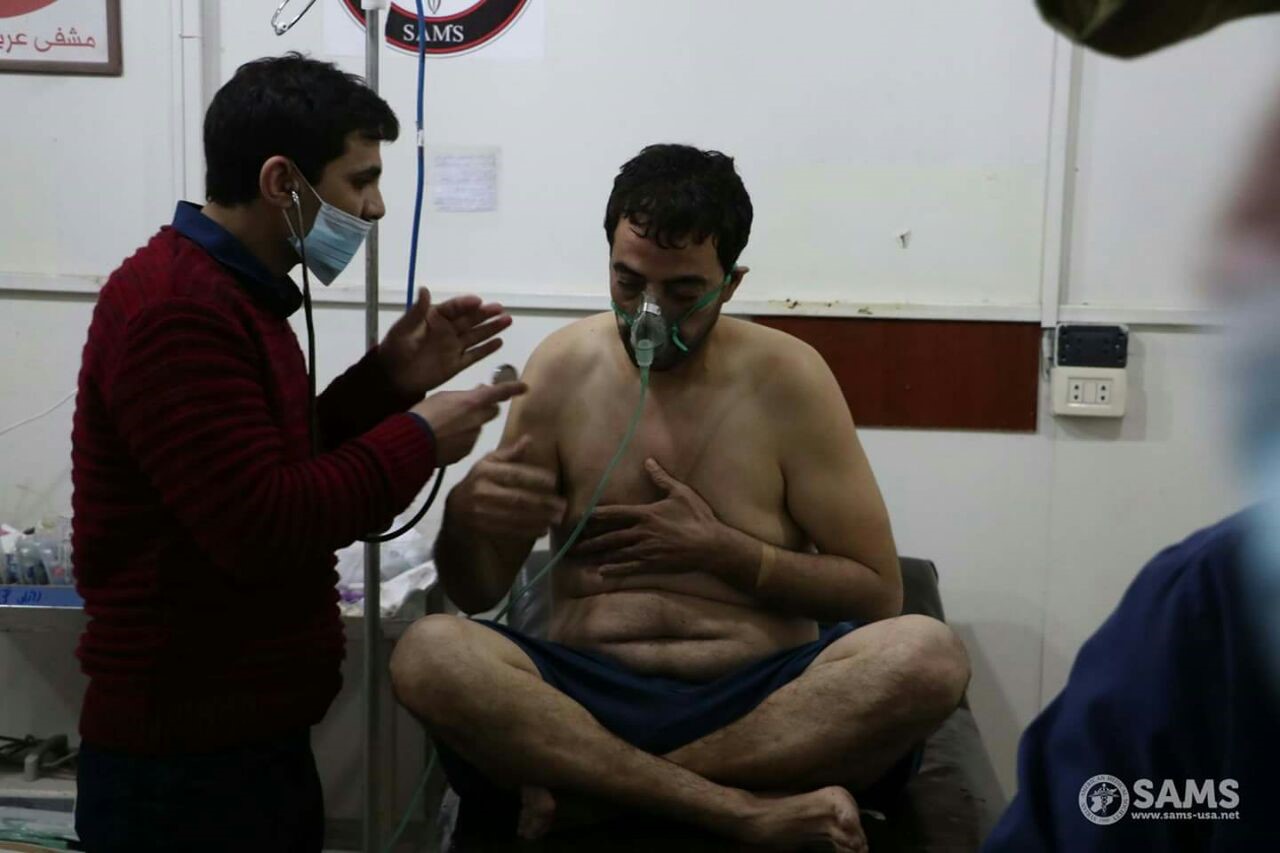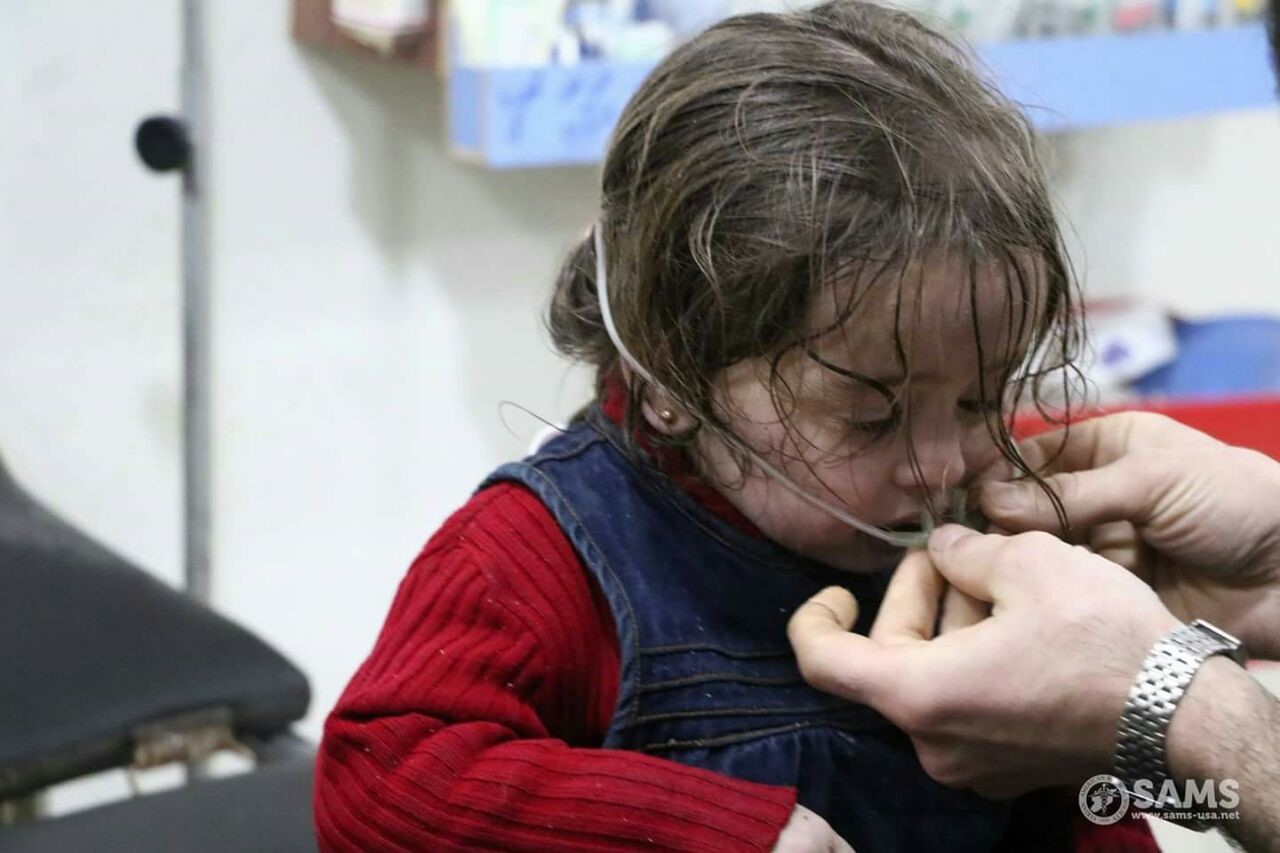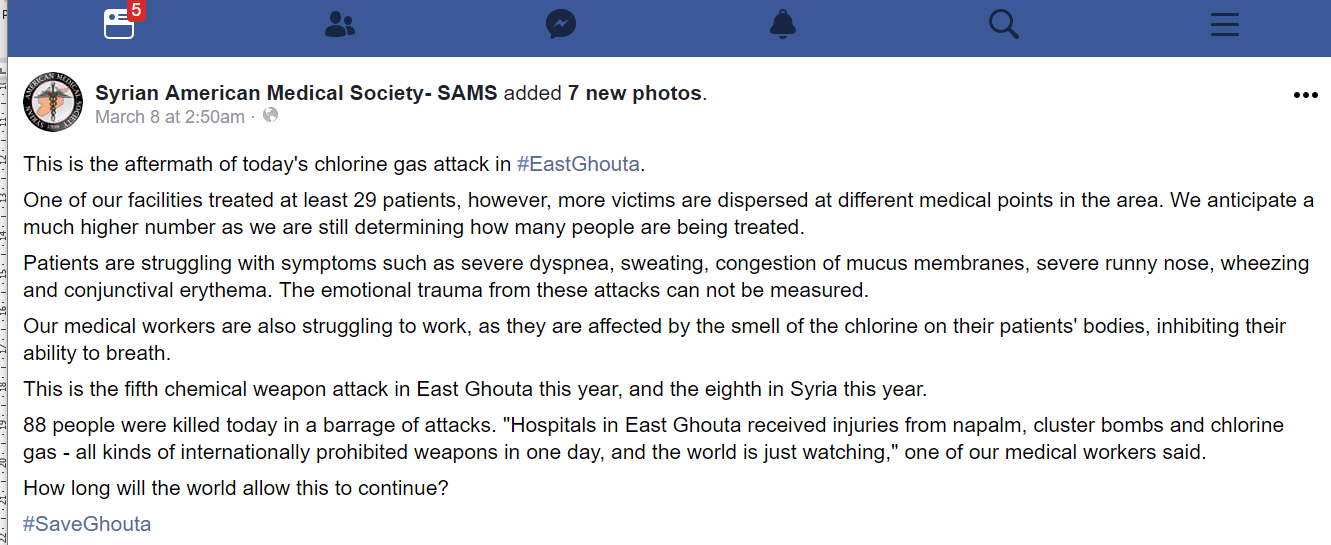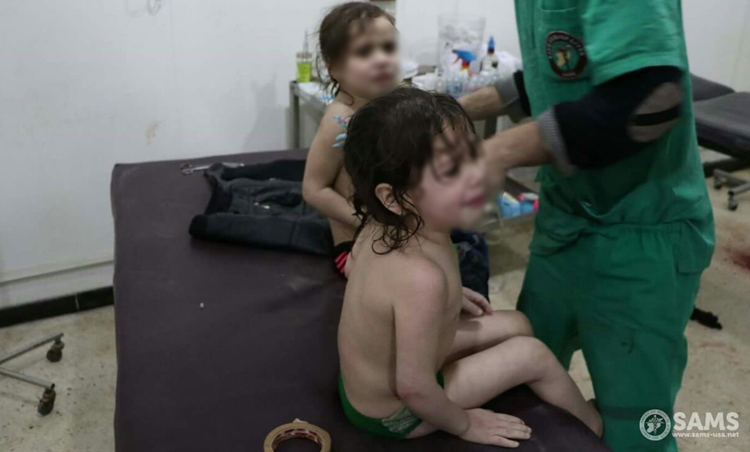Introduction: During their recent military campaign on Eastern Ghouta, the Syrian regular forces and their allies not only used various types of weapons as rockets, barrel bombs, and incendiary materials, but also used toxic gases for the fifth consecutive time since the beginning of 2018. On March 7, 2018, the residential neighbourhoods in the area between Hamoryah and Saqba cities were attacked with chemicals. According to many testimonies obtained by Syrians for Truth and Justice/STJ, several rocket “launchers” loaded with gases, whose symptoms are similar to that of chlorine gas, fell on those neighbourhoods and caused asphyxia of about 70 civilians, mostly women and children.
The Syrian regular forces had previously used poisonous gases on Eastern Ghouta four times. On January 13, 2018, the first attack loaded with chemicals occurred in the area between Duma and Harasta, wounding six civilians, according to a report prepared by STJ, entitled "Exposure of Six Civilians to Poisonous Substances in Eastern Ghouta – Damascus Countryside," This is the First Attack in 2018 When Chlorine Gas is Used as a Weapon in Ghouta."
On January 22, 2018, the Syrian regular forces resumed the use of poisonous gases on Eastern Ghouta in 2018, when residential neighbourhoods of Duma were subjected to another attack with poisonous gases, suffocating 21 civilian, according to a joint report prepared by STJ and Bellingcat, titled "Syrian Forces Use Chemical Weapons in Duma for a Second Time in a Month."
The third attack occurred on February 1, 2018, when Duma town was hit by poisonous gas, injuring three civilians with asphyxia, according to a joint report prepared by STJ and Bellingcat, titled "German materials" Again Used in Chlorine Gas Rockets in Eastern Ghouta, This is the third attack by Syrian regime and its allies since the beginning of 2018 in Ghouta.
The fourth attack occurred on February 25, 2018, when Shifuniyah town was hit by poisonous gas, causing suffocation of many civilians, and killed two children at least, according to a previous report by STJ, titled "Syrian Forces Bombard Eastern Ghouta with Chemical Weapons for the Fourth Consecutive Time since the Beginning of 2018."
Cities and towns of Eastern Ghouta have not experienced such difficult days as those during the recent military campaign, given the Syrian regular forces discriminately destroyed some areas (almost completely) in order to achieve military advance on the ground, the STJ’s field researcher said.
It should be recalled that the Syrian regular forces and their allies had reached an agreement agreement with Faylaq al-Rahman on March 23, 2018, in order to evacuate to northern Syria the armed men of Failaq al-Rahman and of Hayat Tahrir al-Sham(HTS)/al-Nusra Front along with their families, as well as civilians who wish to. The agreement included towns of Irbin, Zamalka, Ayn Tarma and Jobber. There was a similar previous agreement on March 21, 2018, reached by the Syrian regular forces and their allies with Ahrar al-Sham al-Islamiyya Movement in Harasta city and led to the evacuation, to the north, militants of the Movement along with their families in addition to civilians who wished.
On February 24, 2018, the UN Security Council adopted resolution No. (2401) amid a welcome by the United Nations, which called for a ceasefire to enable the delivery of humanitarian aid and the medical evacuation services of the critically sick and wounded. The United Nations Office for the Coordination of Humanitarian Affairs (OCHA) has described the situation in Syria as "bleak" in the wake of the UN Security Council resolution calling for a 30-day ceasefire throughout the country.
Details of the Incident
At approximately 9:15 pm on 7 March 2018, the Syrian regular forces shelled the area between Hamoryah and Saqba with poisonous gases, concurrently with violent bombardment, which was confirmed Amjad Yassin, who hails from Hamoryah city. He said:
"The area between Hamoryah and Saqba was targeted with rocket launchers that did not explode on impact on earth, which raised our suspicions, because usually the rockets that we do not hear the sound of their explosion are loaded with poisonous gases. Only minutes later, strange smells began to disperse into our shelters. People had fled their homes into the cellars fearful of intense shelling focused on their towns and cities, but this time, death knew its way to us through the air. On the evening of the same day, we heard one of the neighbours screaming "chemicals!", so panic spread everywhere and mothers hugged their children in an attempt to protect them, but in vain. Many people began to suffocate and could not go up because of the intensity of the shelling. The ambulance teams were unable to reach the impact site due to the rubbles in all neighbourhoods of the town, so people started to go out while barrel bombs falling over their heads let alone the rockets loaded with incendiary materials that exploded everywhere."

An image showing a person with asphyxia due to inhaling poisonous gases in Eastern Ghouta on March 7, 2018.
Photo credit: Syrian American Medical Society (SAMS).
Following this attack, Dar Al-Shifa Hospital in Hamoryah City received the first cases of suffocation, mostly children and women. Hassan Issa, one of the nurses working at the hospital confirmed this and spoke to STJ,
"At around 9:30 p.m., the hospital received the first cases; most of the injured had reached on foot, and given our staff was not able to reach the impact site because of the heavy shelling and the piles of rubbles everywhere. Moreover, the regime was deliberately targeting the ambulatory teams. More than 70 cases of suffocation have arrived the hospital, but we documented only 40 because of their large numbers. The majority of the cases were dispatched to Saqba Hospital, being the closest to the impact site."
The symptoms showed on the injured were severe shortness of breath, congestion and wheezing during breathing along with severe runny nose, Issa said, and pointed out that smell, like of chlorine, had clearly smelt from clothes of most of the injured, he added:
“I have never had such a day, most hospitals and medical points had been already overcrowded with the wounded from violent shelling. Nevertheless, that day the hospitals piled up with them. The medical staff knew not rest. We cannot say that chlorine gas was the gas used in the attack, because it might contain other toxic substances rather than chlorine; we have not been able to analyse it given the poor potentials."

An image showing a child who had been suffocated by inhaling poisonous gases in Eastern Ghouta on March 7, 2018.
Photo credit: Syrian American Medical Society (SAMS).
On March 7, 2018, a video footage published by activists showed some people suffer from asphyxia due to inhaling poisonous gases in Hamoryah city. Another video footage published by Smart News Agency showed that, on 7 March 2018, some civilians had asphyxia due to inhaling poisonous gases.
The Syrian Medical Society (SAMS), through a release on March 8, 2018, said that one of its hospitals in Eastern Ghouta just a day earlier had received (29) persons suffering from symptoms likely to be because of inhaling toxic chlorine gas, such as shortness of breath, sweating, congestion, runny nose, and wheezing during breathing. SAMS said that the attack, laden with poisonous gases, is the fifth of its kind on Eastern Ghouta since the beginning of 2018.

An image of SAMS release on March 8, 2018, concerning the attack loaded with poisonous gases on Ghouta on March 7, 2018.
Photo credit: SAMS.

